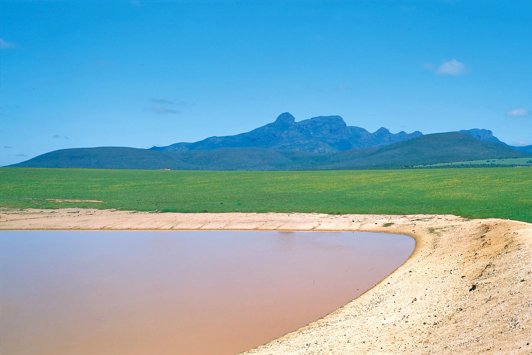Managing land degradation due to earthworks
The Soil and Land Conservation Act 1945 (SLC Act) is in place to mitigate the risk of land degradation due to practices that may adversely affect land and water.
Mitigation and repair of land degradation is covered by the SLC Act, which includes soil erosion, salinity, eutrophication, flooding and the removal or deterioration of natural or introduced vegetation that may be detrimental to the present or future use of the land.
Some or all of this kind of degradation may occur as a result of inappropriate water drainage when management earthworks are carried out.
Notify the Commissioner
Type of water management earthworks requiring notification:
- Surface water management: No requirement to notify the Commissioner.
- Groundwater management: Submit notice of intent to drain (NOID) to Commissioner.
For any groundwater management earthworks that are planned, it is a legal requirement for land owners and occupiers to give at least 90 days’ written notice to the Commissioner of Soil and Land Conservation of an intent to drain subsurface water to control salinity, and discharge that water onto other land, into other water or into a watercourse, even on the same property.
Submit notice of intent to drain or pump waterUnderstanding surface water vs groundwater management
Each type requires landholders to comply with specific conservation earthworks regulations under the SLC Act when planning or carrying out water management activities and practices.
Surface water earthworks only intercept and redirect surface water flow. They are used where there is a risk of water erosion, where water movement control or water harvesting is required, and/or as part of a water management program.
Legal requirements
Each landholder has a duty of care to make sure that flows from earthworks are not discharged indiscriminately on a neighbouring property (which may also be covered by common law) and that stream flows are not significantly diminished or degraded.
Notification not required*
The Commissioner and DPIRD do not require notification of intent to undertake surface water management earth works.
*However, any land degradation caused by any of these surface water management options is covered by landholder obligations under the SLC Act.
Recommendation
Conservation earthworks can ameliorate (lessen) or exacerbate (make worse) land degradation. Therefore, to avoid degradation associated with earthworks, and to ensure compliance with the SLC Act, DPIRD recommends using expert advice to plan the works and using appropriately qualified contractors when constructing works.
Draining or pumping to remove groundwater can help to lower water tables and alleviate problems with salinity. The practices may be part of an integrated water and salinity management program. Common strategies to assist management of saline areas may also include installation of desalination systems, and the discharge of reject water from these systems.
Notification is required
Under the Soil and Land Conservation Regulations 1992, a landowner or occupier must give at least 90 days' notice to the Commissioner of Soil and Land Conservation.
The notification covers an intent to drain or pump groundwater to control salinity, and discharging that water onto other land, into other water or into a watercourse, even on the same property.
The notice must be in writing using the notice of intent to drain or pump (NOID) form. Find this below.
Breach of Act
It is a breach of the Act and an offence to proceed without notification, and penalties and prosecutions may be applied.
What other regulations may affect conservation earthworks?
Ensure you follow up on all the legal requirements that may apply to your specific situation. Pay particular attention to regulations and permits relating to surface water management.
DWER administers the Rights in Water and Irrigation Act 1914 (RWI Act) A permit is required in a proclaimed surface water area when you intend to obstruct or interfere with the beds and banks of a watercourse. More information is available from the following information sheets and map.
Information sheet: Do I need a permit?
Information sheet: Supplementary Information for Permit Applications to Interfere with Beds or Banks of a Watercourse
Map: Surface Water Proclamation Areas
DWER also administers the clearing provisions of the Environmental Protection Act 1986 (EPA Act)
Clearing native vegetation is an offence, unless done under a clearing permit or the clearing is for an exempt purpose.
More information about clearing permits is available on the WA.gov.au website
Landholders may be required to comply with legislation administered by the DBCA.
Waterways and wetlands in catchments are important for nature conservation and local ecology as well as local drainage and floodwater discharge. Avoid disturbing the normal patterns of flow and the natural water balance of existing ecosystem.
All Aboriginal sites in Western Australia are protected under the Aboriginal Heritage Act 1972 (AH Act) and it is an offence to harm an Aboriginal site without the prior issue of an approval under the AH Act.
All queries regarding activities that might harm Aboriginal cultural heritage should be directed to DPLH: info@dplh.wa.gov.au
Your Local Government Authority (LGA) may have by-laws and other restrictions on earthworks and water movement from those earthworks.
Check with your LGA before implementing any conservation earthworks.
Before considering any drainage proposals and notifying the Commissioner, landholders should be aware of the principles applied during the NOID process. They are drawn from the Policy framework for inland drainage.
What about common law?
Legislative requirements always override common law. Earthworks and other activities on your farm that adversely affect a neighbour may be covered by common law (laws made by the Courts and not by legislation). To avoid conflicts requiring court action, comply with legislative requirements, and consult with any person or organisation that may be affected by your conservation earthworks.
Where can I find out more or ask a question?
Further information on landholder’s obligations is available under the SLC Act and on the DPIRD webpages that cover the management of salinity, drainage and soil conservation, or by contacting the office of the Commissioner of Land and Soil Conservation.

